 Interface Morphology Prediction with Robust and Efficient Structure Search (IMPRESS)
Interface Morphology Prediction with Robust and Efficient Structure Search (IMPRESS)
Aalto University, Finland, 7-9 June 2017
Organisers: Dr Milica Todorović (Aalto University, Finland), Dr Oliver T. Hofmann (Technical University of Graz, Austria), Prof. Patrick Rinke (Aalto University, Finland)
Funding: CECAM, Psi-K, NOMAD CoE, Aalto University CMMP doctoral network
Introduction
Determining or predicting the structure of organic ensembles on surfaces is a challenging problem that occupies basic science and engineering alike. Recently, novel machine-learning approaches have started to compete with more traditional, stochastic methods, such as basin hoping or simulated annealing. In IMPRESS, we took an interdisciplinary stance and brought together assorted experts to focus on the challenges of organic/inorganic interfaces: this is the first workshop to unite different electronic structure methods, structure search approaches and machine learning.
Programme
The participants gathered at the Aalto Design Factory for morning coffee at 9am on every morning of the event. On Wednesday (7 June), Patrick Rinke from Aalto University welcomed everyone and introduced the daily format of interchanging invited talk, contributed talk and discussion sessions. Noa Marom (Carnegie Mellon) opened the event with a session on molecular morphology in thin films and solids, with Sabine Klapp (TU Berlin) and Reinhard Maurer (Yale University) reporting their work on thin film morphology studies. The following three contributed talks (Packwood, Scherbela and Todorović) featured some emerging solutions where machine learning techniques were employed in studies of molecular surface adsorption and thin film formation.
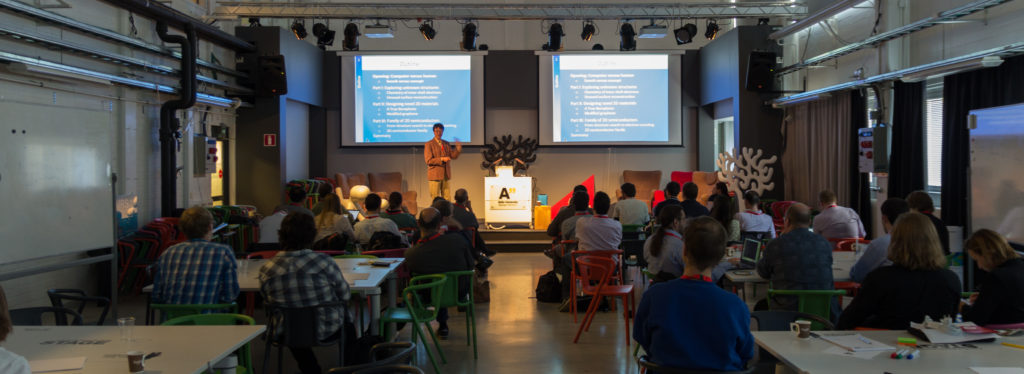
Conversations continued over lunch and through the 2h discussion session. The last session of Wednesday addressed chemical simulation accuracy: novel methodology was presented by Volker Blum (Duke Univeristy), Maosheng Miao (California State University Northridge) and Harald Oberhofer (TU Munich). The programme ended with a busy poster session at the ADF, where diverse new structure search techniques were discussed over wine and quiche. The participants then enjoyed a walk across the sunny green lawns of Aalto’s Otaniemi campus to enjoy a Welcome Party at 19h. The party allowed all guests to relax and enjoy typical Finnish foods and beers as well as an art exhibition on use technological materials in clothing, organised by Aalto’s School of Art.
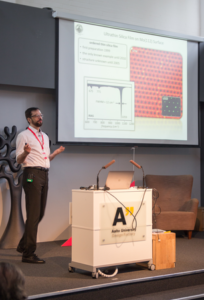
On Thursday (8 June), we focused on machine learning solutions for morphology in solids with Luca Ghiringhelli (FHI), Kari Laasonen (Aalto University) and Marek Sierka (Jena University). New techniques were put forward in a contributed talk session (Karttunen, Jørgensen and Chen), before another 2h discussion session. The final session of the day brought together versatile recent method developments for structure prediction from the groups of Stefan Gödecker (University of Basel), Yanming Ma (Jilin University) and Andrew Peterson (Brown University). Towards the evening, the event shifted to Helsinki city centre for the Workshop Dinner hosted by restaurant Nokka. Finnish gin & tonic drinks were waiting for all guests to enjoy over the views of Helsinki city harbour. Locally sourced Finnish food was served, and everyone was surprised by the unusual taste of sea-buckthorn juice hidden in the desert.
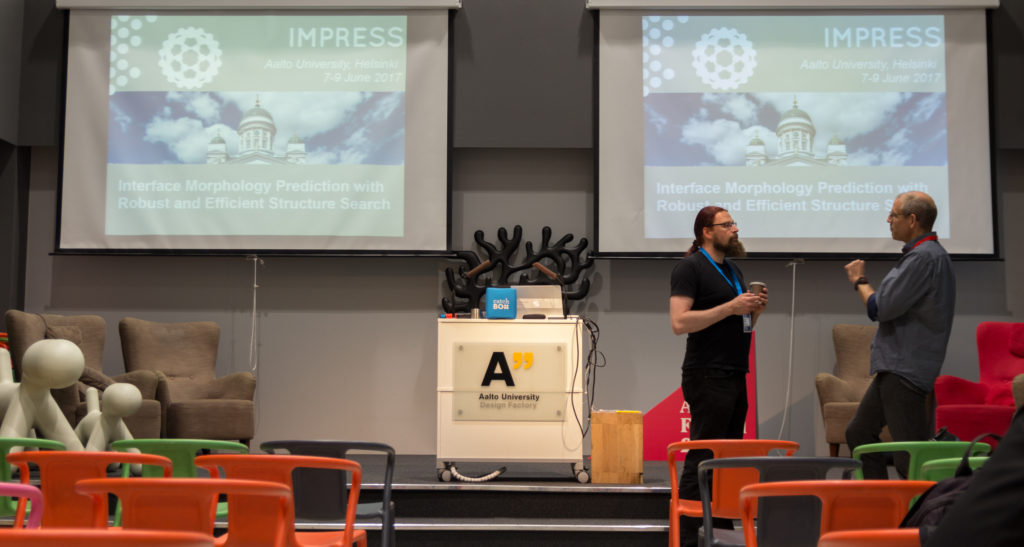
The last day of the workshop (Friday 9 June) was opened by Anthony Reilly (Dublin City University) with an review of recent successes in the Crystal Structure Prediction Challenge and the outlook on method development. The next session of contributed talks was dedicated to structure search and morphology of solid interfaces (Schusteritsch, Hirvonen and Kloppenburg), and we enjoyed a final discussion session. The workshop was closed at midday by Patrick Rinke with a look back at the topics discussed and the best poster prize award. Uffe Furlig Larsen, representing Aahrus University, won with his contribution “Estimating Improvement Potential in an Evolutionary Algorithm”.
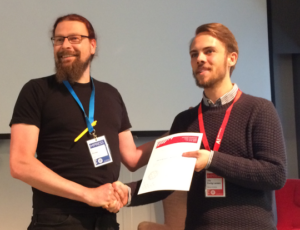
Financial support from Psi-K, CECAM, CMMP doctoral network (Aalto University) and NOMAD allowed us to bring together 45 participants from 12 countries (including USA, China and Japan). It enabled us to keep the event free of registration costs to encourage the participation of younger researchers. We were particularly glad that Prof. Bjørk Hammer (Aarhus University) brought five young group members who showcased their high quality work in oral and poster sessions.
Discussions
The field of structure prediction for interface studies is undergoing a renewal with the influx of machine learning approaches. At the same time, no consensus has emerged to date on how to address some key challenges that all developers face. It was our intention to use invited talks as fuel for discussions on some open questions during three long discussion sessions.
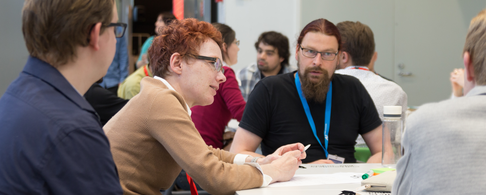
Each day, for two hours, the lecture hall was transformed into a brainstorming space with 4 discussion areas. The panel at each table was hosted by an invited speaker on a key topic of their own choice: these were advertised in advance to allow participants to join several panels. Conversation was lively, with ideas flowing on post-its and illustrated on whiteboards. Fresh fruit, coffee and fruit smoothies were served throughout. All participants contributed thoughts and conclusions to the online questionnaire tool (Presemo) for each discussion table, and discussed at the end of each session.
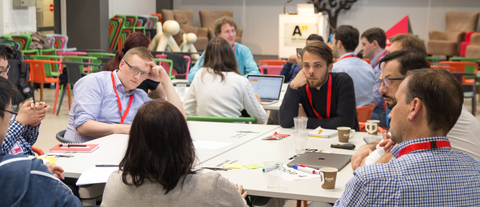
The online tool allowed us to summarise the conclusion from the discussion sessions. The majority of our speakers were concerned by the difficulties in simulating film growth in a grand canonical ensemble, and much discussion was devoted to including particle flow, finite temperature, entropy and defects into the state-of-the-art simulations. Other concerns included the better design of materials descriptors or algorithms for machine learning for optimal results, as well as the realisation of complex workflows that combine several approaches. Adjusting interatomic potentials on-the-fly was another topic of interest in method development circles owing to their favourable scaling with system size. Access to higher energy structures instead of just global minima was of paramount importance in comparisons with experiment.
Workshop links
Workshop flyer | IMPRESS website | Abstract book
List of Invited Talks (13)
- Volker Blum (Duke University, USA): The Material that Wasn’t There. Or, Would the Real Atomic Structure Causing Some Exciting Property Please Stand Up?
- Luca Ghiringhelli (Fritz Haber Institute, Germany): Learning descriptors from materials-science (big) data
- Stefan Gödecker (University of Basel, Switzerland): Structure prediction with the Minima Hopping Method
- Sabine Klapp (Technical University Berlin, Germany): Coarse-grained modelling of the structure, phase behavior and non-equilibrium surface growth of anisotropic molecules
- Kari Laasonen (Aalto University, Finland): Modeling of complex metal alloys and nanoparticles via multiscale first-principles methods
- Yanming Ma (Jilin University, China): Structure Prediction via Swarm Intelligence Algorithms
- Noa Marom (Carnegie Mellon University, USA): Effect of Crystal Packing on the Electronic Properties of Molecular Crystals
- Reinhard Maurer (Yale University, USA): Collective curvilinear coordinates in interface structure and function prediction
- Maosheng Miao (California State University Northridge, USA): Activating inert electrons and idle orbitals by high pressure
- Harald Oberhofer (Technical University Munich, Germany): “Cheap” DFT for structure prediction, and what else it is good for
- Andrew Peterson (Brown University, USA): Machine-learning algorithms to accelerating electronic structure calculations
- Anthony Reilly (Dublin City University, Ireland): Organic Crystal Structure Prediction: Blind Tests, Progress and Challenges
- Marek Sierka (Jena University, Germany): Atomic Structure of Oxide Materials: Synergy Between Theory and Experiment
List of Contributed Talks (9)
- Daniel Packwood (Kyoto University, Japan): Machine learning and dissimilarity analysis for surface-assisted molecular self-assembly
- Michael Scherbela (TU Graz, Austria): Structure Prediction at Organic/Inorganic Interfaces using Gaussian Process Regression
- Milica Todorović (Aalto University, Finland): Efficient Bayesian Inference of Surface Adsorbate Structure
- Antti Karttunen (Aalto University, Finland): Crystal structure prediction of inorganic-organic coordination polymers
- Mathias S. Jørgensen (Aahrus University, Denmark): Combining Evolutionary Algorithms with Clustering toward Rational Global Structure Optimization at the Atomic Scale
- Xin Chen (Tsinghua University, China): Decompose local energy with artificial neural network
- Georg Schusteritsch (University of Cambridge, UK): Predicting the structure of interfaces using the Ab Initio Random Structure Searching method
- Petri Hirvonen (Aalto University, Finland): Multiscale modeling of polycrystalline graphene
- Jan Kloppenburg (UC Louvain, Belgium): The interfaces of 3×3 SiC-0001 ̄ with graphene and IrO2 with water under applied potential
Conclusions
The number of workshop participants from different backgrounds and the variety of approaches presented testifies to the resurgence of interest in the field of global structural optimisation and increasing attention to structures at the interface. Presently most groups carry out this research as a side activity. Given the potential impact of novel methods and the volume of open questions, it is expected that funding applications on this topic will help to consolidate this field in future years.
Even after extensive discussions produced lots of interesting suggestions, many open questions remain. It remains difficult to compare different simulation methodologies and it is not clear which ones will emerge as most versatile and transferable in the years to come. In machine learning-based approaches, there is ongoing debate over the role of algorithm choices and data representations on the results obtained. It remains uncertain whether employing low-accuracy fast simulation techniques is beneficial and where, or whether on-the-fly parameterisation is a better solution where accurate simulations are prohibitive. Furthermore, most techniques address a particular lengthscale (atomistic-nanoscale) and it is not clear how to extend them to multi-scale approaches for more realistic studies.
The workshop brought together contributors from Europe, USA and China that originate from different communities (physics and chemistry), and many of them have not met before. We have identified a clear need for more networking and discussion in this field. Given the time scales needed to advance present approaches, participants have agreed that biennial (once every two years) meetings may serve this community best. On the other hand, the close relationship between method development and experimental work has exposed a need for a scientific exchange with the experimental community
